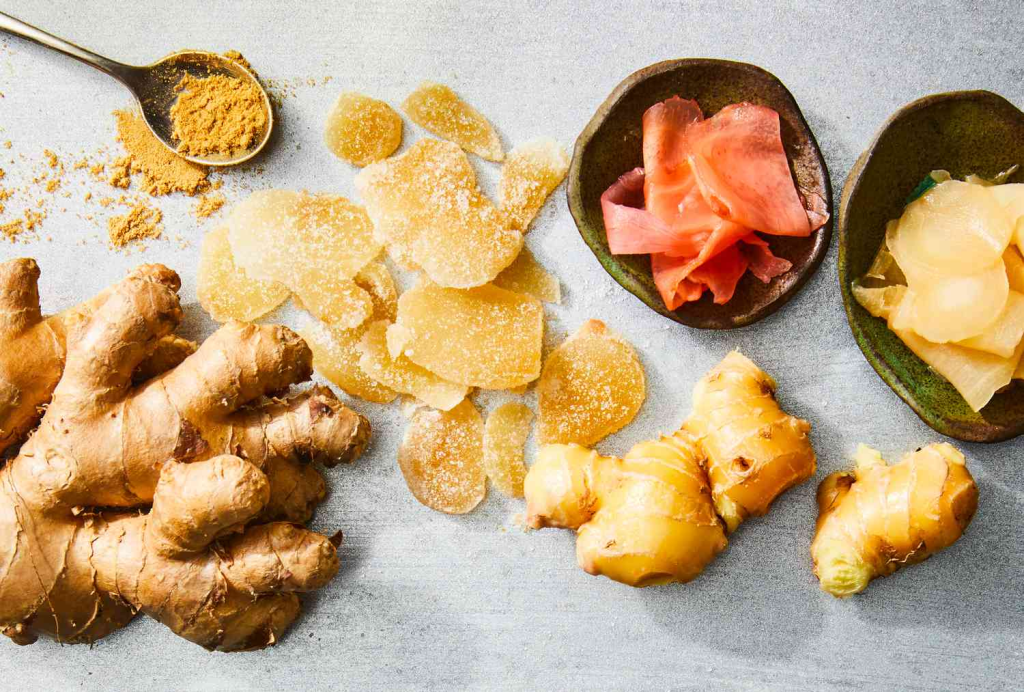What is Ginger?
Ginger is a captivating ingredient; full of spice and intrigue, it’s a sneaky scene-stealer in the kitchen. Gnarled and beige, it may not look like much, but this unassuming root is a powerhouse of flavor — tantalizing sweetness mingled with an underlying zingy, mouth-filling heat. There are countless ways to cook with fresh ginger to enliven your cooking and baking.

Alliums regularly used in cooking include garlic, onions, leeks, scallions, shallots, and chives, so you may immediately feel lost if you need to remove them from a recipe, but an easy substitute is fresh ginger. Like alliums, ginger is a great aromatic base to start with. It can easily be added to the mirepoix of French cuisine, which normally consists of onions, celery, and carrots, or the Italian mix of soffritto, which starts out the same as mirepoix but to which gets added garlic, fennel, and parsley.
While some people love the pungent flavors of alliums, others have an aversion and can’t stomach the taste. For onion haters, the tiniest hint of it in a dish will ruin their day. Some individuals are allergic to or intolerant of alliums altogether, which means favorites like French onion soup and garlic bread are off the menu. But all is not lost. With some willingness to experiment with new flavors, fresh ginger is an excellent stand-in.
How to cook with ginger instead of onions or garlic
Ginger has a strong and unique flavor that is described as spicy, warm, peppery, sweet, pungent, and piquant. It is an integral part of Asian, Southeast Asian, African and Caribbean cookery, and prevalently used in the cuisines of India, China, Thailand, Japan, Nigeria, and Jamaica. Asian dishes are particularly adaptable to switching out onions or garlic for ginger. While the flavors are not the same, ginger can still provide that savory, fragrant punch usually imparted by alliums.
One of the most fantastic things about ginger is how versatile it is. From savory dishes to sweet desserts, there’s often a place for fresh ginger. You’ll find it in many cuisines around the world.
Ginger is a popular aromatic in Asian cuisines like Chinese, Japanese, Korean and Indian, where it shows up in marinades, sauces, soups, stews, curries and dressings. You’ll find similar usage throughout the Pacific Rim, including Hawaiian and other Polynesian cuisines.

Fresh ginger is less common in European cooking, but dried, ground ginger stars in classic European desserts like gingerbread and ginger cookies and in liqueurs and aperitifs. In Eastern Europe, it shows up in some pickles and preserves. Substituting or adding fresh ginger can boost the flavors of these recipes even more.
How to prep fresh ginger
It might look intimidating if you’ve never handled fresh ginger before, but it’s easy to work with. Here’s how to prep it and cut it just right to use in whatever you’re cooking:

- Peel it: Grab a spoon and use the tip to scrape the thin skin off the ginger root. The skin is very thin, so it comes off easily, and the spoon tip is perfect for getting around the knobby contours. Note that peeling ginger is mostly an aesthetic choice as the peel has little or no discernable flavor.
- Grate it: Grating fresh ginger breaks it down into a pulp, releasing the flavorful juice. The fine texture blends well into sauces, marinades, dressings and batter for baking, distributing the ginger flavor evenly throughout the dish. Use a microplane grater, if you have one, for the best results.
- Chop it: Chopping ginger into small pieces or chunks gives a milder flavor compared to grating because less of the ginger’s surface area is exposed. Chopping is perfect when you want the ginger flavor to be a noticeable element of the dish but not be overpowering. The pieces of ginger will also add a bit of crunch and a burst of flavor when bitten into. Just make sure the pieces aren’t too large, or you might give diners too much of a jolt. Ginger is fibrous, so it can be a challenge to chop. Be sure to use a very sharp knife.
- Sliver or slice it: Larger pieces of ginger are great for steeping — either in a broth or liquid for tea or other beverages. You can cut ginger into coins or matchstick-size pieces. When making a stock, broth or beverage, add the pieces along with the other flavoring elements like vegetables, bones or tea.
- Mince it: Mincing ginger results in tiny pieces, but not as fine as grating. Mincing is a popular method for incorporating ginger into stir-fries, sautés and other dishes where you want the ginger to integrate fully with the other flavors but still have a bit of texture. As with chopping, you want to use a sharp knife to mince ginger effectively.
- Release the flavor: Heating fresh ginger releases its intense flavor. If you’re making a stir-fry, quickly saute the ginger in oil before adding other ingredients. Steeping it in hot liquid or adding it to a hot dish towards the end of cooking achieves a similar result.


